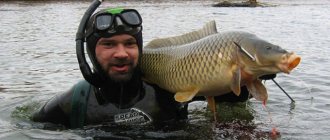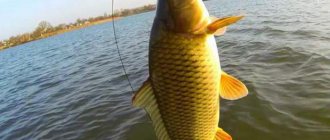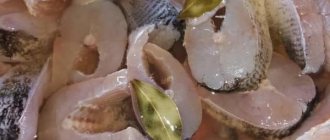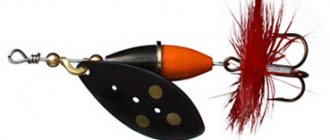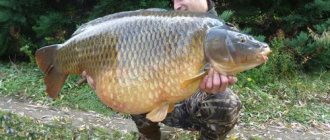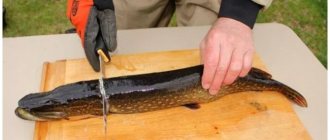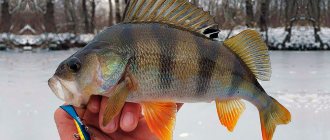According to many underwater hunters, the best reward for work and appreciation for a high level of dexterity is the caught fish. And it doesn’t matter at all whether it is an exotic species or a “simple” representative of the river fauna. Judging by the reviews, spearfishing for pike is very popular in Russia. Why is this predator so in demand among fishermen? You will find information about the features and rules of underwater hunting for pike in this article.
Meeting a river predator
The high popularity of underwater hunting for pike is due to the fact that this species is very common in our reservoirs. It is not for nothing that pike is also called the “king fish”. It was mined back in the days of Ancient Rus'. It is unlikely that there will be an angler who has never encountered this predator. Judging by the reviews, having caught a pike, even an avid crucian fisher will be delighted with the catch. This spotted fish is a very interesting, hardy and seasoned opponent. There are individuals over a meter long and weighing more than 10 kg.
What is special about catching the “king fish”?
Judging by the reviews, the spice of underwater hunting for large pike is added by the fact that this predator has a fighting character. It is recommended to finish her off during her first throw. There were cases when a fish, unable to find its bearings in the midst of a fight, quickly attacked hunters and then swam away, leaving several bruises or more serious wounds. According to experienced fishermen, it is undesirable to become the target of a pike attack, since this predator has very sharp teeth. In addition, the pike's jaw is designed in such a way that the teeth can allow the victim into the mouth at the right moment. If during a fight the pike loses a few, they will soon grow back.
For those planning to spearfish for pike in the daytime, experts advise carefully inspecting the underwater roots of trees. During daylight hours, the fish hide there. Closer to night, the predator emerges from its hiding place.
Large specimens try to be near the bottom, lighter specimens, on the contrary, rise to the upper layers. However, pike is not a fish that will swim at the very surface of the reservoir. The success of underwater hunting for this representative of river fauna directly depends on who reacts first: the person discovers the victim and fires a shot, or the fish senses the approach of danger and swims away.
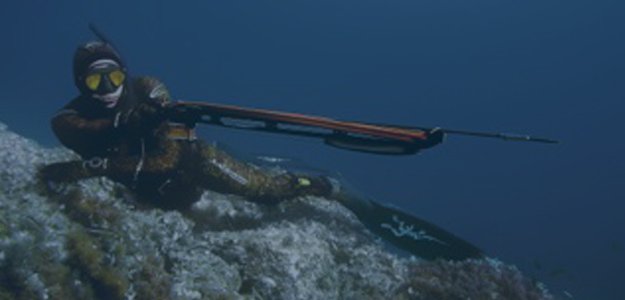
The hunter should remember that the predator will not give a second chance and will go to quieter places. Experts recommend starting hunting after visual preparation: you need to be thoroughly familiar with the outlines of this fish, the structure of the body and its movements. There should be a clear picture in your mind, which will allow you to detect the pike even among abundant reed thickets. Many hunters, moving along the bottom, freeze for a while. This time is used for a detailed inspection of the bottom. Since the pike protects its territory from other fish, it periodically sticks its head out of the shelter to inspect its possessions, thereby giving itself away.
According to experts, during hunting you can use indirect signs of the presence of this fish. It is easy to determine that a pike is nearby by looking at clouds of turbidity. In order for the process of catching this predator to go smoothly and bring results, you should know the secrets of underwater hunting for pike.
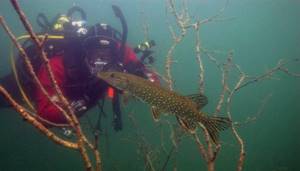
Predator feeding and spawning
Any small living creature that finds itself in the predator’s field of vision can become its prey: perch, roach, minnows, ruffs and other fish. On occasion, he does not refuse small bream, silver bream, ide, small pike. More than once, villagers noticed that large predators attacked birds and small animals living in the water. Ducklings, mice, frogs, and muskrats can become targets of attack. There are no restrictions for her - she will happily feast on any living creature that is smaller in size.
To learn more:
Is it possible to catch pike from the shore?
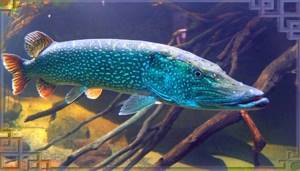
Pike spawning begins soon after the final ice melts, when the water warms up a little. Early spawning is observed in small pikes; large specimens spawn several days or weeks later. Females begin to throw at the age of four, and sometimes three years, males mature a little longer. A shallow place is chosen as a spawning ground - 50-100 cm, where the water warms up faster, which means that the fish will be more active. Here the female lays eggs and the partners fertilize them.
One pike per season can spawn from 20 to 200 thousand eggs - the specific number depends on age and size. Large (up to 3 millimeters in diameter) fertilized eggs have a slightly sticky surface, making them easily stick to objects. But after a few days, the stickiness decreases and they fall to the bottom, where they subsequently grow. The process goes through several stages:
- the egg is not active, develops due to the supply of nutrients;
- The larva hardly moves. It receives everything it needs for life from the yolk sac attached to the stomach;
- The fry swims confidently, feeds on the smallest organisms, gradually turning into an adult.
During spawning, the predator develops a strong hunger, but fishing is not allowed - fishing is poaching and is strictly punishable by law.
Where to begin?
Judging by numerous reviews, most beginners do not know where to look for pike. Spearfishing requires following certain rules. The most universal thing is that pike is always close to individuals that represent its food supply. Since such a representative for a river predator is the ide, then, having discovered a school, we can conclude that a pike is definitely lurking somewhere nearby. According to experts, the predator, having joined the school, periodically pulls out one or two fish.
Which weapon should you choose?
Many pike lovers are wondering which weapon is considered the most effective: pneumatics or crossbow? Experts advise giving preference to the second option.
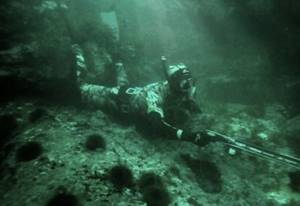
A crossbow is ideal for targeted underwater hunting for pike. The advice of experienced fishermen in favor of crossbows is due to the fact that this weapon is reliable and has high combat accuracy. Judging by the reviews of professional underwater hunters, the following strengths of crossbows can be identified:
- These are shooting devices with a simple mechanism, in which various malfunctions and breakdowns are practically eliminated.
- A crossbow shot is absolutely silent. Which is very important for spearfishing.
- Thanks to the high power of a crossbow, you can hit a target at a distance of no more than 7 m. With a pneumatic weapon, this is possible at a distance of 4 m. This lethality is due to the fact that the crossbow uses the slingshot principle. Since the compressed air in a pneumatic weapon is much weaker than a rubber rod, this explains the high lethality of a crossbow.
It is not worth shooting at the jaw or stomach of a pike, because after performing two or three serious jerks, it will free itself from the arrow. The most lethal place in a predator's body is the spine. Once in it, the hunter manages to completely immobilize the fish.
Description

If you take a closer look at the anatomy of the pike, you will see that its head makes up almost a third of its entire body. The pike's body is noticeably elongated compared to most other fish. The head is long, the muzzle is flat.
The pike has large teeth in the protruding lower jaw and numerous curved back teeth in the upper part of the mouth. Her teeth consist of razor-sharp, curved back teeth that are also found on the roof of her mouth and on her tongue. The teeth automatically straighten when the pike detects its prey.
The dorsal fin is set far back and is almost connected to the caudal fin, an important difference from other fish of the northern hemisphere. Her rear dorsal fin allows her to spin quickly and violently while hunting.
The color is gray, olive green, there may be yellow and white areas on the stomach. Some may have dark spots on the fin side. The color of pike can vary depending on its habitat and can be green, brown or grey-brown.
Young pikes have yellow stripes all over their bodies. It is curious that pike have no scales in the lower part of their gills. Sensory pores can be found on the pike's head, usually located in the lower part of the jaw.
Pike is a skilled and aggressive predator. Its preferred food sources are sick and weak fish, amphibians, young waterfowl, crabs, crayfish and rodents that are found in the water.
Since pike primarily hunt weak and sick fish, including their fellow fish, pike make a significant contribution to maintaining the ecosystem in which they live, keeping it healthy.
We recommend: How to determine the age of a pike
About spearfishing for pike in summer
At this time of year, the spotted predator, like other freshwater fish (chub or silver bream and bream), spend most of the time in the middle horizon. The fish is in constant motion. Since dislocation in the upper layers of the water column is the norm for pike, an underwater hunter should first of all focus his attention on the upper balls of the reservoir. Since pike is considered a very cautious fish, you need to move along the bottom in such a way as not to make a lot of noise. It is advisable to sneak up on her from behind.
According to experts, it is best to approach the river predator from the side. This recommendation is due to the fact that pike has less developed sensory organs on the lateral line, which cannot be said about its vision. At the same time, it is important not to scare off the “king fish” with the light of a flashlight. If you manage to sneak up on the fish from the side, the underwater hunter will have a couple of extra seconds to fire a targeted shot from a crossbow.
Pike fishing gear
You should choose equipment based on the time of year. In summer, the toothy fish bites well on a spinning rod. You can fish from a boat or shore, especially if the fishing spot is deep enough. In the fall, girders are effective - by installing live bait and lowering it into a hole at night, you can count on a catch. At the end of autumn - beginning of winter, experienced fishermen rush to catch pike on the first ice. The thickness of the crust reaches 5-7 centimeters, but the water has not yet had time to cool completely, and the predator bites quite actively. It's time to rush for trophy specimens. For fishing to be successful, you need to take the choice of appropriate gear seriously and remember that fishing methods that are successful in June will be useless in the fall.
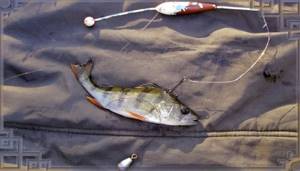
Live bait fishing rod
You can use mugs or a girder, but the bait will always be the same - live bait. This is an extremely passive type of fishing - you just need to put gear in the habitat, set it up correctly and just walk from one to another, waiting for the pike to bite. In your free time you can sit with a fishing rod. When using live bait, it is important to take a heavy load - the bait should not move it from the bottom. With a leash of 20-40 cm, small fish will swim, attracting pike, otherwise it will probably drag the tackle into snags.
To learn more:
Advantages of silicone predator baits
Spinning technique
Spinning fishing using spinners (rotating and oscillating), crank and popper has also proven itself well. This is an active type of fishing - you can’t stop for a second. A throw, a leisurely pull up, and everything repeats all over again. It is advisable to have a good baitcasting reel - it is more pleasant to work with it, and the line hardly gets tangled. A “beard” can really ruin your mood, forcing you to stop fishing ahead of time. You should choose artificial baits, giving preference to those colors that are in the natural color of the predator’s prey in a particular place. To do this, you need to know what pike usually bite here, or experiment with different baits.
Many people look forward to winter so they can start ice fishing. A classic balancer or a small spoon will do. However, girders are successfully used at this time. In January and February it is important to have a fish finder. The ice becomes thick, so even an active fisherman will not want to drill an extra hole.
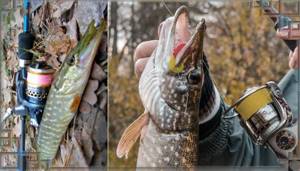
About autumn fishing
According to experienced underwater hunters, the process of catching pike in the fall is quite unpredictable. If we compare the river predator with the burbot, then in early autumn it is less active. However, it is considered more mobile than other types of fish. By November, when the temperature in the reservoir does not exceed five degrees, the pike becomes somewhat more passive and, at the same time, more timid. Fans of spearfishing should take this into account. Otherwise, the fish, sensing danger, may suddenly take off and quickly swim away.
About hunting in winter
During this period, the location of the pike is various aquatic vegetation. According to hunters, it is best to look for this fish in the pondweed bushes. In this case, this representative of the fauna is always in the same position - with its muzzle in the direction of the current. In winter, pike practically do not rise to the middle and upper horizons. This behavior is due to the fact that the fish, being cold-blooded, becomes passive as a result of a decrease in temperature. Thus, by reducing energy consumption, she saves her energy. Judging by numerous reviews, winter is considered a good period for those who are planning to go underwater hunting for pike.
The main advantage of winter fishing is that the hunter has a greater chance of making a targeted shot in the back of a predator. Having sensed the approach of a person, the fish does not react so quickly.
Behavior of pike on the first ice

After the formation of ice, small grass pike, weighing up to 2-3 kilograms, mostly concentrate in shallow coastal areas. The prospects of a place are directly proportional to the presence of shelters in the form of remnants of vegetation, unevenness in the structure of the bottom, snags, and other obstacles, among which a pike can ambush. Its potential victims also choose the same areas, trying to hide in a life-saving support in the event of a predator attack.
There is no point in looking for pike on a clean, flat bottom. There is nowhere to hide in such areas, so neither the predator nor the potential victims feel comfortable here.
Moving on to specifics, we note that the most promising areas for pike fishing at the beginning of the winter period will correspond to depths from 1.0 to 2-2.5 meters.
Often the predator goes to shallower depths in search of fry. This behavior of pike in winter is observed two weeks after the formation of ice, and until the deficiency of oxygen dissolved in the water forces the small fish to go to greater depths. Accordingly, when fishing during the period under review, a completely competent solution would be to install several girders in close proximity to the remains of aquatic vegetation almost under the shore.
A similar picture is observed at the end of the winter fishing period, when at the mouths of tributaries flowing into the main body of water, the level of oxygen dissolved in the water sharply improves, which makes these shallow waters promising for fishing.
Read! Fishing for rotan
Touching upon the topic of the last ice, one cannot fail to mention the peculiarity that in extensive reed thickets the general oxygen situation may be better than in the whole reservoir. And this despite the fact that there is plenty of rotting vegetation in these thickets. This phenomenon is explained by the fact that air inevitably gets under the ice through the hollow reed stems. So you can catch pike in such places.
How to take a shot catch?
Many underwater hunters who catch pike for sport take pictures with their trophy. At the same time, they pose while holding the fish by the gills.
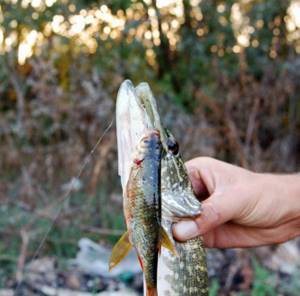
According to experts, this method of grip is only possible if a small specimen is obtained. If you are lucky enough to shoot a 7-12 kg predator, then holding it by the gills is not recommended. Otherwise, the underwater hunter will simply cut his fingers on the sharp gill wings.
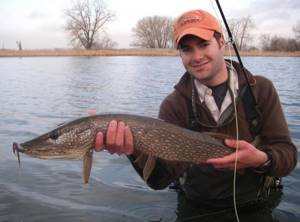
In this case, a person should be as careful as possible and not forget that he has a predator in his hands, trying to get back into the water at any cost. Those who are planning to put a pike on a kukan are advised not to do this in the usual way, as they can damage their gloves and wetsuit. A person will feel much safer if the fish turns out to have its upper and lower jaws pierced. This way, her mouth will be securely fastened. There is also no need to risk damaging your equipment by pulling the kukan to your belt. It is more advisable to thread the needle through the predator’s jaw twice, and then connect it to the front weight.
Where does pike live?
This is a rather conservative predator. If you have found a successful pool and managed to catch several serious specimens, you can visit here again in a week. In summer she often stands near bridges. The water, running around the supports, creates reverse flow zones - predatory fish love them very much. It is worth paying attention to places where washed-out trees lean low over the water. Insects fall from the leaves, small fish prey on them, and pike feast on the small change. But be careful not to get caught on branches when casting.
To learn more:
How to effectively catch pike in winter?
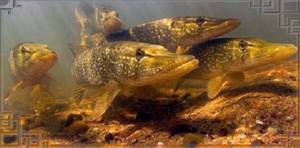
A type of predator, the grass weed, hides in the algae, from where it makes raids on small things floating by, but usually small specimens adhere to this tactic. In September, when the water level in the river decreases, the pike slides into deep pools and lives mainly in them. The number of fish in the bottom depressions may vary - one predator often lives in a small hole, and if it is a full-fledged pool, several trophy specimens may coexist in it. Usually the biggest bait is enough. In November, when fishing on the first ice, it makes sense to choose passages between the reeds - large specimens almost always move along “paved paths”, avoiding swimming into dense vegetation. Knowing where pike are found, you will always return with rich catch.


